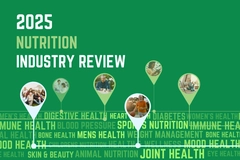
- Industry news
Industry news
Trending now
- Category news
- Reports
Trending now
- Key trends
Trending now
- Multimedia
Multimedia
Trending now
- Journal
- Events
Trending now
- Suppliers
Suppliers
Trending now
- Home
- Industry news
Industry news
Trending now
- Category news
- Reports
Trending now
- Key trends
Trending now
- Multimedia
Multimedia
Trending now
- Events
Trending now
- Suppliers
Suppliers
Trending now
Vitafoods Asia 2025 live: Beneo exhibits Orafti Inulin chicory root fiber for Asian snacking

Beneo is showcasing the applicability of its Orafti Inulin chicory root fiber solution in diverse food applications curated for regional snacking preferences at Vitafoods Asia 2025 in Bangkok, Thailand (September 17–19). Gut-healthy product demonstrations at the show feature a flavored prebiotic water, “brookies,” and “tea gummies.”
Orafti Inulin is derived from chicory root via a gentle hot water extraction method and is one of the few prebiotics recognized internationally by the International Scientific Association for Probiotics and Prebiotics (ISAPP). Research supports that the chicory root fiber can promote the growth of bifidobacteria in the human gut, irrespective of food application or matrix.
On the Vitafoods Asia show floor, Nutrition Insight meets Olivier Roques, CEO and chief sales officer at Beneo, who announces: “I’m proud to say that our prebiotic claims for Orafti Inulin chicory root fiber have been evaluated and formally approved by the Center for Nutrition Assessment and Health Claims of Thailand (CNACT) here in Thailand.”
Roques says the new commercial health claim for Thailand comes following collaboration with Beneo’s scientific and regulatory team at the Beneo Institute.
He discusses how Orafti Inulin chicory root fiber answers regional flavor demands and wellness trends.
What’s driving the demand for healthy aging ingredients right now?
Roques: I would say that healthy aging is not about adding years to life, but rather adding life to years. Southeast Asia is facing a rapidly aging population because one out of six people will be over 65 years old in 2050. Overall, there is a sentiment that there is a movement toward prevention over curing, which is a more Westernized approach.
We see that especially here in Thailand, where 89% of the population agrees that we need to start taking care of aging as early as possible. Beneo understands that the three major problems with unhealthy aging will be digestive problems, high cholesterol, and high blood pressure.
How do Beneo’s prebiotics support gut health in a meaningful way?
Roques: The products we have are based on chicory, and they are the preferred prebiotic for gut health. In fact, they target very specific bacteria you have in your gut, like Bifidobacterium or Lactobacillus strains. This specificity enables a much more effective prebiotic effect. And gut health, as I said before, is a central driver of healthy aging.
This is especially true with regard to the regularity of bowel movements. How you manage constipation relates to how effectively you absorb different nutrients, which in turn impacts your immune system. Something we worked on more recently, for the last two to three years, is the gut-brain axis. Beneo’s prebiotic chicory fibers have a proven, positive modulation on the gut microbiota, which can have an effect on a better mood state — less depression, less anxiety, and fewer negative feelings. This axis is clinically proven, and we are promoting it in different markets, especially here in Asia.
Inulin or oligofructose, which are derived from chicory root, are effective at quite a low dosage of only 3 g per day.
Are Asian consumers catching on to microbiome-focused nutrition? Which foods might be the best delivery systems for prebiotics?
Roques: We observe that in Asia, digestive health is among the most prominent topics in healthy aging. According to a consumer study here in Thailand, digestive health was the second most prioritized area by consumers. The first one was a balanced diet.
.jpeg) Beneo exhibited a “brookie” snack baked with gut-healthy Orafti Inulin chicory root fiber to demonstrate the ingredient’s applicability.Among the samples we have here at Vitafoods Asia 2025, we are presenting a “brookie.” My colleague Noemi from the US designed this recipe. It’s a blend of a cookie and a brownie, containing inulin.
Beneo exhibited a “brookie” snack baked with gut-healthy Orafti Inulin chicory root fiber to demonstrate the ingredient’s applicability.Among the samples we have here at Vitafoods Asia 2025, we are presenting a “brookie.” My colleague Noemi from the US designed this recipe. It’s a blend of a cookie and a brownie, containing inulin.
We also have a crunchy noodle snack, which includes another digestive fiber we call beta-glucan. It comes from the US and is made from barley, which supports heart and cardiovascular health.
Our last feature is a tea gummy, which dissolves in tea. It contains Palatinose, a slow-release sugar derived from beets, which results in more balanced blood sugar levels.
Keep in mind that we need to customize the recipe of a finished product depending on our consumers. Beneo is regionalizing its offerings. For example, we can adapt inulin in recipes that will be specifically compelling for the local market.
I come from France, so a noodle snack is considered exotic in my home market. Locals might typically go for it once a month, but if you want to have it on a regular diet to make a proven effect with 3 g of inulin per day, it is probably not the right product application. Adding inulin to French yogurt, which is very popular there, might be the right avenue.
There are many differences between countries, so we are working heavily to ensure we find the right vehicle to commercialize the product. This is why we are strengthening our application team here in Asia.
Where does sustainability integrate within your health-focused innovations?
Roques: We have a comprehensive plan for sustainability and circularity. By 2030, we want to eliminate food waste in our operations, so we have implemented various programs. Additionally, we are working hard to reduce our greenhouse gas emissions while growing our portfolio.
For instance, we opened a fava bean plant in Europe, producing flour and protein concentrate. This plant has run completely on renewable energy from the beginning. We just opened it in June, and we had the first delivery to customers this September 2025.
For our chicory business, we have two facilities, one in Belgium and the other in Chile. At these plants, we increased our production capacity three years ago while reducing specific energy consumption by 35%, thanks to using a biomass boiler. This generates renewable energy and uses our food waste.
Moreover, our wood supply is sourced from a sustainably managed forest, and the combination of these things helps us significantly reduce CO2.
In Asia, we opened a program with sustainable rice farming in Vietnam with two partners, funded by the Government of Flanders. It’s a three-year-long project involving roughly a thousand farmers. We are currently working with an agency to train them on sustainable and resilient practices to grow and harvest rice.
This is a copy of what we have done in Chile with chicory growers. We provide them all the agronomic support to ensure fertilizer and pesticide use is limited to a bare minimum to have the most sustainable agricultural practices.
What’s next in Beneo’s pipeline for digestive wellness?
Roques: We are working on different products. The last one we introduced is an HMO (human milk oligosaccharide) in collaboration with a partner in Germany. We combined this HMO with chicory fiber because they strengthen the immune system. This allows a better claim at the end of the day, not only for digestion but also for immunity.
So, we work on complementing existing ingredients and are focusing on mapping different agricultural materials, which can help us expand our fiber portfolio.
I want to say that Asia is underrepresented in Beneo. Beneo was created in 2007 in Europe and is very Europe-centric, considering that we understand the market requirements in Europe very well.
This is my first visit to Asia, which has been a huge source of inspiration. Consumers here are very demanding and knowledgeable about health claims. When you look at the population demographic in the world, 4 out of 8 billion people live here among Japan, China, India, and Southeast Asian countries.
It’s obvious that we need to foster our presence here. We need to adapt to the right vehicle, like in the case of the different recipes I mentioned earlier, which are adapted to the Asian market. From a science and health claim point of view, there is already knowledge and appetite from consumers.
I see this as a very strong growth opportunity, because I want to rebalance the three continents: America, Europe, and Asia. We have updated our target for double-digit growth in Asia, because it represents the best growth opportunity for Beneo.











